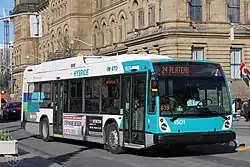Société de transport de l'Outaouais
Société de transport de l'Outaouais (STO) is the transit service of the Outaouais region of Quebec. It operates conventional services and the Rapibus, a bus rapid transit service, in Gatineau, Quebec, including the districts of Hull, Aylmer, Gatineau, Buckingham and Masson-Angers. STO provided limited service to Chelsea and Cantley until June 2015 when Transcollines began operations in the Collines de l'Outaouais MRC. STO is located on the Quebec-side of Canada's National Capital Region, and operates several bus routes through Downtown Ottawa, Ontario.
 A STO Novabus LFS HEV on Wellington Street in Ottawa | |
| Founded | 1971 |
|---|---|
| Headquarters | 111, rue Jean-Proulx Gatineau, Quebec J8Z 1T4 |
| Locale | Outaouais |
| Service area | Gatineau and Downtown Ottawa |
| Service type | Bus service, paratransit |
| Routes | 66 |
| Stations | 11 |
| Fleet | 345 buses[1] |
| Annual ridership | 19.4 million (2010) |
| Fuel type | Diesel, hybrid |
| Chief executive | Patrick Leclerc [2] |
| Chairperson | Jocelyn Blondin [3] |
| Website | sto.ca |
History
Prior to 1971, public transportation in Gatineau was operated by private sector companies, including Hull Electric Company and later Compagnie Transport urbain de Hull.[4] In 1971, these companies had a total of 42 buses and 2.5 million clients.[5] This same year, the Commission de transport de la communauté régionale de l'Outaouais (CTCRO) was created to improve regional transportation services that would otherwise exceed the means of the constituent cities.
In 1972, for $6.25 million, CTCRO purchased 8 private transit companies in the region: Transport urbain de Hull, Transport Hull métropolitain, Transport d'écoliers du nord de l'Outaouais. A year later, the CTCRO created an agreement with OC Transpo to make transfers between the two services easier.
It purchased only air-conditioned buses from its first one, 1990. In 1991, it changed its name to Société de transport de l'Outaouais (STO)
In 1998, the STO was named the "Canadian public transit operator of the year" by the Canadian Urban Transit Association (CUTA). From 1999 to 2001, to satisfy growing demand, the STO purchased additional second-hand buses from the Société de transport de Montréal, Société de transport de Laval, Société de transport de Sherbrooke and OC Transpo. They all have since been retired.
The STO introduced its first fleet of low-floor buses from NovaBus in 2002, and it has only such buses since then. The following year, the STO announced plans to build a bus-only roadway called the Rapibus. The project was initially expected to be completed by 2009, but it was finally opened in 2013.
In 2005, the STO announced a strategic plan for 2002-2015 in which it projected a ridership of 96 million by 2019 up from 2.4 million in 1992. Ridership from 1995 to 2006 had grown about 50%. In addition to the Rapibus, the STO planned to increase the number of park and ride facilities across the city as well as introduce bike racks, expand or add garages, and expand the fleet.[6]
In 2012, it introduced its fleet of Novabus LFS articulated buses and the following year, it unveiled their new visual identity – L'avenir en commun (in English: the future together) as well as a new logo.
In 2013, STO launched a new bus rapid transit (BRT) system called Rapibus, which includes a dedicated 12-kilometre corridor that runs from Labrosse Boulevard to Alexandre-Taché Boulevard.[7][8]
In 2015, the STO bought 10 Classics from Calgary Transit, the last buses to be purchased second-hand from another company.
In February 2020, the last Classic bus (#9225 an ex-Calgary Transit unit) retired, marking an end to the iconic bus model of the STO which span for more than four decades.
In June 2021, STO buses in downtown Ottawa were re-routed from Wellington Street and Rideau Street to Albert Street and Slater Street, using the bus lanes that had previously formed the downtown section of the Transitway until they were made obsolete by the opening of the Confederation Line.
Operations
According to its 2014 annual report, STO employed a total of 780 employees, of which 479 were drivers. It also has a total of 345 buses, 70 routes and 284 shelters. Its ridership in 2014 was approx. 19.8 million, a slight decrease from previous years. Similar to other cities, it also paratransit service (about 60 vehicles of various sizes) as well as Park-n-Ride service (23 locations as of 2014).[9]
Fleet
Since 2002, Novabus LFS's have been purchased annually to replace older vehicles and to expand the fleet over time. All generations have been purchased except the first generation as OC Transpo (its sister company) have found its first generation Novabus LFS's to be unreliable.
| Model | Years | Fleet # | Length | Fuel Type |
|---|---|---|---|---|
| LFS 2nd generation | 2003-2009 | 0314-0328 0401-0417 0501-0517 0601-0617 0701-0716 0801-0819 0901-0910 |
40 ft Standard | Diesel |
| LFS 3rd generation | 2009-2013 | 0911-0925 1001-1027 1101-1107 1201-1233 1301-1321 |
40 ft Standard (09XX-11XX, 1227-1233) 60 ft Articulated (1201-1226, 13XX) |
Diesel |
| LFS 4th generation | 2014–present | 1401-1414 1501-1507 1601-1616 1701-1730 1801-1827 1901-1909 2001-2043 2101-2114 2201-2216 |
40 ft Standard (15XX, 1610-1616, 1716-1730, 18XX-22XX) 60 ft Articulated (14XX, 1601-1609, 1701-1715) |
Diesel (2014) Diesel-Electric "Hybrid" (2015–present) |
| Model | Years | Fleet # | Length | Fuel Type |
|---|---|---|---|---|
| GM New Look | 1972-1983 | 7206 7301-7320 7401-7425 7501-7520 7601-7610 7701-7710, 7742 & 7757 7801-7817 7901-7907 8001-8015 8101-8103 8201-8204 8301-8312 |
40 ft Standard | Diesel |
| GM/MCI/Novabus Classic | 1984-1997 | 8401-8406, 8413 8501-8509, 8536, 8539, 8545-8546 8601-8604, 8614, 8620, 8624 8785 8801-8808 8901-8915 9001-9015 9101-9138 9201-9225 9401-9426 9501-9520 9601-9603 9701-9705 |
40 ft Standard | Diesel |
| Nova RTS | 2000 | 0001-0012 | 40 ft Standard | Diesel |
| Nova LFS 2nd generation | 2002-2003 | 0201-0209 0301-0313 |
40 ft Standard | Diesel |

Accessibility
The STO planned to convert half of its total bus fleet into low-floor, LFS model NovaBus by 2012.[10] Unfortunately, the more recent models had a decreased seating capacity (room for 37 rather than 40). Another issue that was discovered with this model were the unreliable telescopic ramps that prevented wheelchair access to the bus. As of 1988, the fleet had wheelchair accessible buses. These were of the 1995 first-generation LFS's, which have the more reusable flick-out rooms.[9] Aside from these plans, wheelchair users rely on the paratransit service.
Technology
A number of significant technology improvements and studies have been made over the past few decades by the STO. In 1998, the company introduced a smart-card fare system, making it the first company not only in the Americas but the entire Western Hemisphere to have a smart-card system. Paper card bus passes were gradually phased out until its official end in 2004 when smart cards became the exclusive bus pass.[11]
In 2006–07, fishbowl buses had their rollsigns replaced with LED signs. In 2002 and again in 2007, the STO tested new hybrid buses for feasibility. During the summer of 2008, the STO has started a test trial of a prototype New Flyer articulated bus on several of its routes. The bus has 58 seats and a total capacity of 115 passengers.
In 2014, STO added Wi-Fi to several of its lines, including all buses and stations associated with Rapibus.[12] In 2015, STO announced plans to introduce the bus planning App called Plani-Bus [12]
Future
STO is studying whether Gatineau's future transit needs will best be met by mixed rapid transit (bus rapid transit and light rail) or light rail only.[13] It has not been decided how an STO rail line would connect with OCTranspo's O-Train system.[13]
See also
References
- "Steering glitch forces dozens of STO buses off the road". CBC News. March 14, 2017. Retrieved May 18, 2023.
- "Nomination de madame Line Thiffeault au poste de directrice générale de la STO". Société de transport de l'Outaouais. August 29, 2013.
- "Myriam Nadeau". Ville de Gatineau.
- "Civilization.ca - Architecture of Old Hull - Hull Electric Company - History". Canadian Museum of History. Retrieved June 24, 2023.
- "About the STO – Looking Back". Retrieved May 18, 2023.
- "About the STO – STO's 2005–2015 Strategic Plan". Retrieved May 18, 2023.
- "New Rapibus system has launched in Gatineau". CBC News. October 19, 2013. Retrieved May 19, 2020.
- "Rapibus". Ville de Gatineau. Ville de Gatineau. Retrieved May 19, 2020.
- "Mission" (PDF). Sto.ca. Retrieved November 17, 2016.
- 2002 User's Guide
- "About the STO -Kudos". Retrieved May 18, 2023.
- STO.ca. "Users guide (French only)" (PDF). Retrieved November 17, 2016.
- "STO confirms Gatineau will get light rail l". CBC News. January 31, 2020.